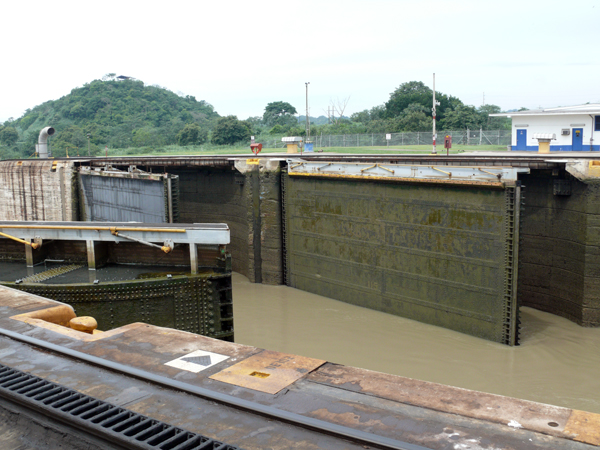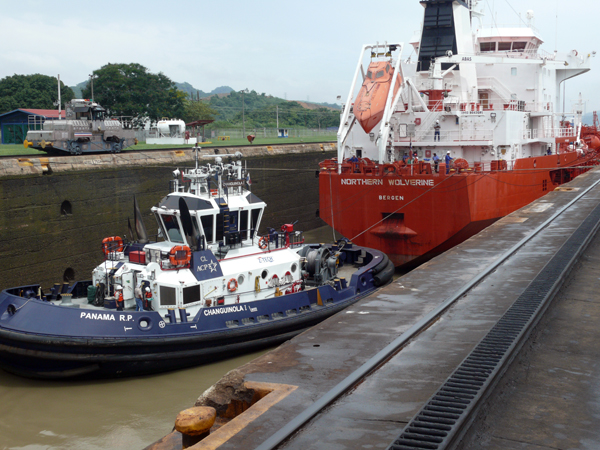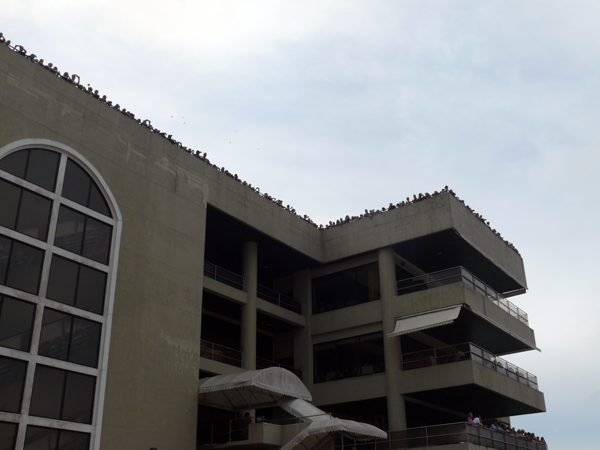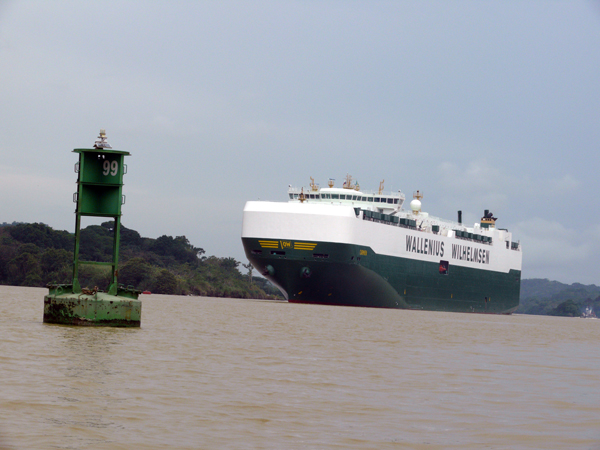PANAMA CITY - For the dozens of people lined across the full length of the observation deck atop the Miraflores Visitors Centre, the Panama Canal represents one of man’s greatest engineering achievements – right up there with Egypt’s pyramids and China’s Great Wall.
For the ships slowly moving through the locks, lakes and river that make up the 80-kiloemetre canal, it represents to shortest distance between two oceans – saving time and money for the shipping industry.
For Panamanians like Judith Rios, the canal is a symbol of national pride – a statement to the world that Panama is a country that deserves global respect.
“This canal is not just water and ships and steel gates; it’s the lifeblood of my country; it showcases to the world what Panamanians can do when they put their minds and backs to it,” says the impassioned Rios as she unlocks an iron gate and leads a group of journalists to the edge of the grand canal that took 10 years and cost over 20,000 lives to complete.
There is not a Panamanian who doesn’t revere the great canal; doesn’t underestimate the economic benefits it brings to this developing nation; doesn’t swell with pride knowing that when the United States handed the canal back to Panama in 1999 - under strict conditions - many people, especially the Americans, had doubts the Panamanians were up to the task of running it.
“We proved them all wrong,” boasts Rios as we watch a giant cargo ship enter the Miraflores locks from the Pacific Ocean – the first of six locks and two fresh-water lakes the ship will navigate before reaching the Atlantic Ocean on Panama’s opposite coast; a tedious journey that normally takes between eight to 10 hours to complete.
“The Americans ran the canal for 86 years and all Panama ever got over all that time was one billion U.S. dollars,” says Rios. “But since we took control in 1999, the canal contributes $4 billion (U.S.) annually to our economy and we use that money to build hospitals to treat our sick and schools to teach our kids.”


Left: The giant steel doors that control water levels were made in Pittsburgh. Right: Tug boats and tiny locomotives are used to keep ships steady in the locks.
The huge ship called the Northern Wolverine out of Bergen in Norway is the last ship to be allowed into the locks from the Pacific side on this sunny day– “in the mornings we move ships from the Pacific to the Caribbean Sea (Atlantic) and the afternoon is reserved for ships moving from the Atlantic to the Pacific,” Rios tells us before warning the small group not to get too close to the locomotive pulling the great ship through the locks.
“The locomotives (one on each side of the lock) keep the ship centered but they (the engines) cost a lot of money, so in the future when the canal is finished being widened we will be using tugboats,” says Rios.
There’s much excitement in Panama these days about the expansion of the canal, which, when completed, will allow super tankers to cut through the Continental Divide.
“The expansion will double the capacity of the canal and will be completed on its 100th anniversary (in 2014),” boasts Rios.
Another source of pride for Rios is that the Panama Canal is the only waterway in the world where complete control of a vessel is handed over to a pilot and the ship’s captain becomes an observer.
“Only a Panamanian pilot can guide a ship through the canal and we employ 288 of them and they are well respected and well trained,” says Rios.
The canal has become Panama’s second largest employer after education – more than 9,700 people (13 per cent of Panama’s workforce) rely on what Rios calls “this universal legacy” for their livelihood.
The canal is also the country’s biggest tourist attraction – over 1,600 people crowd onto the observation deck on a normal day to see ships from around the world be loaded into the locks, whose seven storey high steel doors were forged in Pittsburgh before being brought here in the early 1900s.
Rios does not dismiss the American ingenuity that was needed to build this wonder of the world; she and other Panamanians just wish they hadn’t hung around for so long after it was built.


Left: Each day thousands of visitors crowd the observation deck of the Panama Canal. Right: Just outside Panama, you can actually take a boat in one of the lakes created to feed the great canal.
In fact, why America gets most of the credit for completing the canal, history reminds us that it was the French who actually started digging it back in 1880 when they occupied the country. Malaria and financial problems forced the French to abandon the project and the Americans took up the challenge, completing the canal on August 15, 1914 - and the world was changed forever.
According to Rios, “2010 was a very important year for the Panama Canal because the millionth ship passed through it (the bulk carrier Fortune Plum now holds that distinction thanks to its crossing on Sept. 4, 2010).
Each year, on average, more than 14,000 ships travel along the 401 of waterways and they pay a hefty toll to do so – the average cost for a ship to use the canal is well north of $140,000 and the highest toll fee ever paid was by an Asian container ship that had to ante up over $400,000. On an average day, Panama collects over $2 million in tolls.
“And the tolls must be paid 48 hours before the ship enters the locks,” says a stern looking Rios.
The canal also welcomes over 210 passenger ships each year and to give visitors a unique experience, local operators offer day-long Panama Canal voyages on tour boats.
“But nothing matches the experience of being on one of those ships when they enter the first lock,” beams Rios, who has watched the great iron doors open (it takes one minute and 48 seconds for the gates to open) and close on many occasions from the deck of a ship.
But what’s truly amazing about this engineering feat is that two manmade lakes (Gatun Lake and Miraflores Lake) had to be built to supply fresh water to the canal – seawater would erode the steel gates over time. The lakes are fed by the Rio Chagres – the river known as Alligator River in English has no alligators swimming in it.
Ships entering from the Caribbean Sea side are lifted 26 metres above sea level in three locks before reaching Gatun Lake. From there they travel through the Culebra Cut, the point where the Rio Chagras flows into the lake, and then start their decent by entering the Padro Miguel Locks, Miraflores Lake and the two Miraflores locks before being spit out into the Pacific.
A museum inside the visitor’s centre chronicles the building of the canal and the hardships crews endured during its construction – thousands of lives were lost and thousands of others were uprooted from places like Barbados and China to help build the canal, which explains why Panama City boasts one of the biggest Chinatowns in Latin America and why there’s such a Caribbean influence in Panamanian cooking?
The museum also employs interactive exhibits to explain how the canal works and one of the most talked about displays is the one showcasing the giant bugs, like cockroaches the size a big man’s fist, that workers had to contend with during the building process.
There’s a number of other places scattered about Panama City that are connected to the canal and should be visited; like:
- The handsome administration building that sits on a hill overlooking the canal. It opened exactly one month before the canal on July 15, 1914;
- The Goethals Monument, a unique marble monument dedicated to George Goethals, the engineer who completed the canal construction;
- The Monument to the Martyrs of January 9th , which was erected in 2003 as part of the Republic of Panama’s Centennial celebrations;
- And the Panama Interoceanic Canal Museum, located in Panama City’s Old Town, which chronicles the country’s history, its native culture and the canal.
Panama is a country where the world meets and it’s all thanks to the Panama Canal.